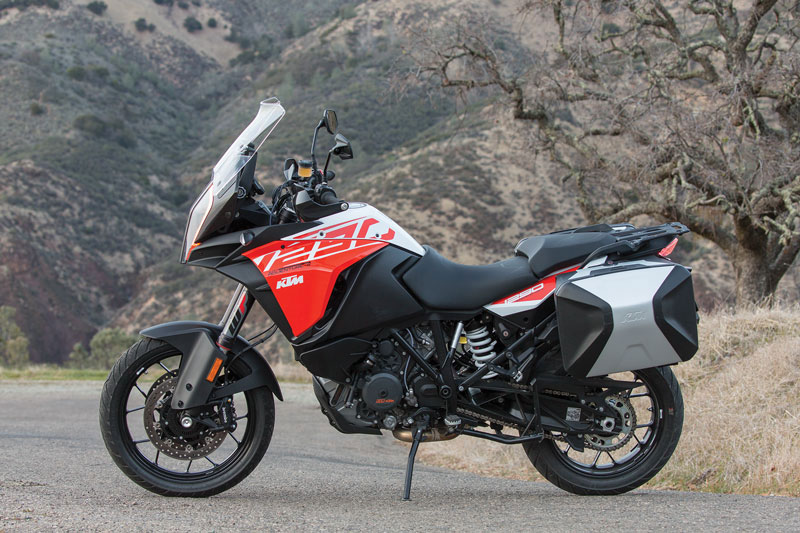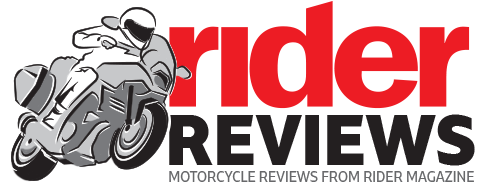2018 KTM 1290 Super Adventure S

Road Test Review
With aggressive, chiseled design by Kiska and modular architecture, KTM’s range of liter-class motorcycles share common elements (engine, trellis frame, instrumentation) but are tailored to individual missions. The beating heart of the lineup is the liquid-cooled, 75-degree LC8 V-twin that’s been bulked up and sharpened over the past 15 years, from the original 942cc, 98-horsepower, carbureted version that powered the 2003 950 Adventure to the 1,301cc, 177-horsepower, fuel-injected version in the latest 1290 Super Duke R. True to KTM’s “ready to race” philosophy, the LC8 has proven itself time and again, from winning the Dakar Rally in 2002 to smashing the two-wheel record in the Pikes Peak International Hill Climb in 2017.
We’ve tested—and been impressed by—nearly all LC8-powered models over the years, but KTM made a quantum leap forward in 2014. That’s the year it shifted from the raw-and-rowdy era of the 950/990 Adventure to the state-of-the-art era of the 1190 Adventure, striking a more even balance between on- and off-road performance and showcasing emerging technology (it was the first production motorcycle to offer cornering ABS).
And just as the 950/990 Adventure was the genesis for spin-off models like the Super Duke, Super Enduro and Supermoto, the 1190 Adventure gave life to the 1290 Super Duke R naked sportbike, the 1290 Super Duke GT sport tourer (read our long-term review here) and the latest crop of adventure tourers—the off-road-ready 1090 Adventure R and 1290 Super Adventure R and the new street-focused 1290 Super Adventure S.
A distinctive design element now shared among several KTM models is a vertically split headlight array outlined by a pair of bright-white LED daytime running lights that resemble downturned horns, like a bull ready to charge. On the 1290 Super Adventure S, the array houses parallel sets of vertically stacked LEDs with low beam, high beam and cornering lights that illuminate sequentially as lean angle increases.
Replacing the analog tachometer and dual monochrome digital displays used for the past several years is a 6.5-inch, full-color TFT display that automatically switches from a white background in bright light to a black background in low light.
Also new are auto-cancelling turn signals, the Race On remote keyless system for the ignition and fuel cap (inside the fob is a spring-loaded key for removing the seat and locking/removing the accessory panniers), a waterproof smartphone compartment with a USB charging port in the cockpit and the KTM My Ride Bluetooth system. And our test bike is equipped with the optional Travel Pack ($524.99), which adds Hill Hold Control, Motor Slip Regulation and Quickshifter + (up and down clutchless shifting).
When the 1290 Super Adventure S arrived, we immediately pressed it into service, using it as our photo mule for a 850-mile comparison test ride to Joshua Tree National Park. In addition to a fast shutter finger, photographer Kevin Wing also has a quick wrist, and he was hard to keep up with on the KTM even though it was laden with fully loaded factory accessory Touring Cases ($1,199.99) and his heavy backpack was stuffed with camera gear.
That was a cold, blustery couple of days, and in terms of comfort and wind protection the 1290 passes muster. Its height-adjustable seat (33.9/34.4 inches) is hard and its windscreen, which is manually adjustable on the fly over a 2-inch range, provides only moderate coverage though it deflects airflow smoothly. But wind-blocking hand guards and heated grips keep hands warm, and, as with most adventure bikes, rider ergonomics are spacious and the seating position is upright and comfortable.
Pack mule, thoroughbred, trail horse, spirited bronco—pick the equine metaphor for the experience you desire and the 1290 Super Adventure S will deliver thanks to its four riding modes (Sport, Street, Offroad and Rain), Motorcycle Stability Control (multi-mode, lean angle-sensitive ABS and traction control) and WP semi-active suspension with four damping settings (Sport, Street, Comfort and Offroad), pushbutton-adjustable rear preload and nearly 8 inches of front/rear travel.
Cast aluminum wheels in 19-inch front and 17-inch rear sizes carry Pirelli Scorpion Trail II 90/10 adventure tires that favor on-road performance but have moderate off-road capability (we stayed on the pavement for this review, but we’ve off-road tested other KTM Adventure models and they’ve been more than up to the task). Add in standard features like cruise control, a tire-pressure monitoring system, a centerstand, a luggage rack and integrated mounts for accessory panniers, as well as a 6.1-gallon tank that’s good for more than 200 miles, and what you get is a well-rounded motorcycle for sport and adventure touring.
That’s what I love about today’s do-it-all adventure bikes: the only thing holding me back is my imagination. Well, that and the usual obligations of employment, family and a mortgage. But seriously, as a Rider staffer I get more opportunities to ride than most, and when it comes to types of bikes and styles of riding, I’m omnivorous and voracious.
Capable, versatile, exciting bikes like the 1290 Super Adventure S feed all my appetites. For weeks I’ve been commuting on the 1290, and those 50 round-trip miles are a nerve-jangling journey of clogged freeways, lane sharing and traffic lights. With the panniers and luggage rack I can easily transport whatever I need, and with damping set to Comfort the bike floats over U.S. Route 101’s ubiquitous concrete seams. And the KTM My Ride system and smartphone app, with my Sena headset and iPhone paired to the bike, allows me to display and control incoming calls (I decline those while riding), music and turn-by-turn navigation.
On a rare rainy day, I switched over to the Rain riding mode, reducing power, softening throttle response and increasing traction control sensitivity to better deal with the slick conditions. And on a recent morning’s commute, a big, red banner saying “rear tire pressure low” flashed on the TFT display to get my attention. I monitored the front and rear tire pressure readings on the dash to determine whether to pull over immediately or keep going, and with tire pressure holding steady, I was able to make it to work to do the necessary repair, appreciative that the bike was looking out for me.
Turn down a desolate winding road, switch over to Sport mode and hold onto the reins—as soon as you give it the spurs, the 1290 launches eagerly into a full-on gallop, lightening the front wheel and mashing the rear contact patch into the pavement. This is riding at its thrilling, adrenaline-fueled best, with a lively, powerful V-twin wrapped in a high-caliber chassis with cutting-edge electronics.
In Sport mode, this version of the 1,301cc LC8 makes 132 horsepower at 9,300 rpm and 81 lb-ft of torque at 7,400 rpm at the chain-driven rear wheel, in a bike that weighs 535 pounds soaking wet. Street mode softens throttle response a bit and ratchets up traction control sensitivity, but it still delivers full power. Rain and Offroad mode, on the other hand, dial down engine output to 86 horsepower and 63 lb-ft of torque, taming the 1290’s red-blooded temper for tricky conditions.
Regardless of the condition of the pavement or the radius of the curve, the KTM is unflappable. There’s no hesitation in the electronic throttle’s response, there’s never any doubt that the semi-active suspension will keep the chassis calm and the tires in contact with the road and there’s nothing but confidence coming from the strong, communicative Brembo brakes.
And I never gave a second thought to shifting the slipper clutch-equipped 6-speed transmission, especially when clicking through multiple clutchless upshifts while hard on the gas (for downshifts I prefer using the clutch for a bit more finesse). The 1290 Super Adventure S feels solid and well integrated, with no glaring deficiencies or compromises.
My two complaints about the 1290 are the same ones we’ve had about KTM Adventures in the past, and they perhaps stem from its performance-oriented nature: the seat is too hard and the engine radiates too much heat. Installing KTM’s accessory Ergo seat may solve the seat issue, but it costs $199.99 and increases seat height by 0.8 inch (a heated version is also available). Engine heat, on the other hand, is less amenable to a quick fix.
After nearly 2,000 miles of testing, we’re not ready to give the 1290 back and I’m looking forward to our next multi-day adventure. While writing this, I wandered down memory lane and recalled past trips I’ve taken on its predecessor, the 1190 Adventure—a challenging press launch ride around Mount Teide, a volcano in the middle of the island of Tenerife; a multi-day comparison ride and staff campout in Central California, with a few dirt roads thrown in; and an 11-hour superslab ride out to Moab, Utah, for a couple days of trail riding, followed by a scenic return trip through Bryce and Zion National Parks.
Exactly the sort of adventure touring the 1190 was designed for, a mix of conditions and surfaces and speeds. And the 1290 Super Adventure S is more powerful, more sophisticated and better equipped in every way to handle whatever adventure you have in mind. Just remember to drop your mortgage payment in the mailbox on your way out of town.
